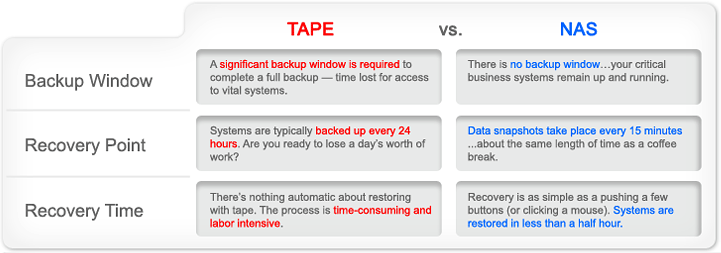NAS vs. Tape
Though tape backup is common, it’s far from being an ideal BDR solution. Analysts have said that over half of tape backups fail, so chances are that if you need to restore from tape, you’ll be out of luck. But assuming all goes well with tape backup, how does it compare with the NAS appliance?
What Happens If My Server Crashes?
Now let’s look at how our solution keeps your business running if, for instance, an e-mail server goes down.Because the device takes snap shots every 15 minutes, administrators can choose a point in time shortly before the problem occurred and with just a few clicks of the mouse, this appliance allows you to activate it as a virtual server to keep business processes up and running while we diagnose the problem and plan a course of action for the down email server.
In the event of a catastrophic server failure, our business continuity solution also includes a boot CD that allows us to perform a bare metal restore on new hardware in a fraction of the time of a typical server rebuild. And, this NAS device restoration will allow you to eliminate the hardware abstraction layer during the restore process so that the new drivers can be loaded on the server replacement, no matter which server brand is used — giving you speedy recovery options in times of crisis.
Recovery after a Catastrophe
If a disaster results in your end-client losing their entire office — servers and on-site NAS included— you order a newly imaged NAS with the most current backup-normally the last daily that was done, to be shipped out via next business-day air transportation to a location of your choice. If such an event occurs, we will not host the data at the co-location facility. Depending on the NAS model used, multiple servers can be virtualized on one NAS even as the NAS continues to perform backups of other servers.When the NAS arrives, all you need to do is plug in a patch cable and you’re up and running. This recovery service will allow you to use the NAS for two weeks before it must be returned or purchased. This timeframe should allow you to get a new server ordered, in place and do a bare-metal restore from the NAS before returning the NAS. Alternatively, you can choose to keep the NAS and you will be billed for the list price of the new NAS. This would also allow you to use this NAS for the ongoing backups when you move forward, re-establishing the network for your client.
Off-Site Storage Facility
For additional protection in the event of a complete disaster, data is securely transferred to an off-site co-location facility on a daily basis. Then, in event of such an occurrence, you will receive a new NAS device imaged with your latest data. The storage facilities are two XO high-availability data centers in Phoenix and Baltimore. They provide:- Backup images stored at the data centers on a Storage Area Network (SAN) at the primary facility, then replicated to the secondary facility
- Connectivity provided by multiple providers with automatic failover capabilities
- Facilities provide two fiber optic network drops for our backbone
- Full physical security at each facility including security cameras and key card access
- Network is secured with high-end redundant, automatic failover firewalls
- Fire suppression and environmental control provided
- Automatic back-up power provided with on-site generators


What Our Customers Say